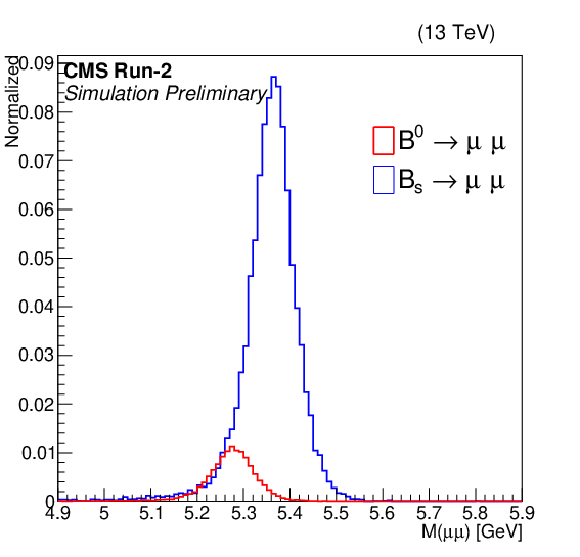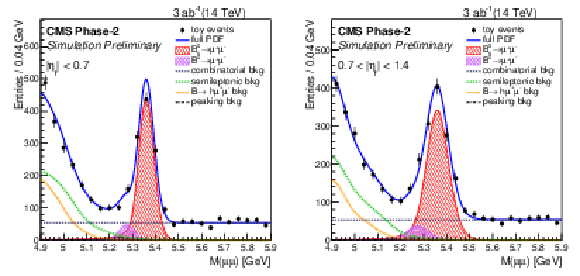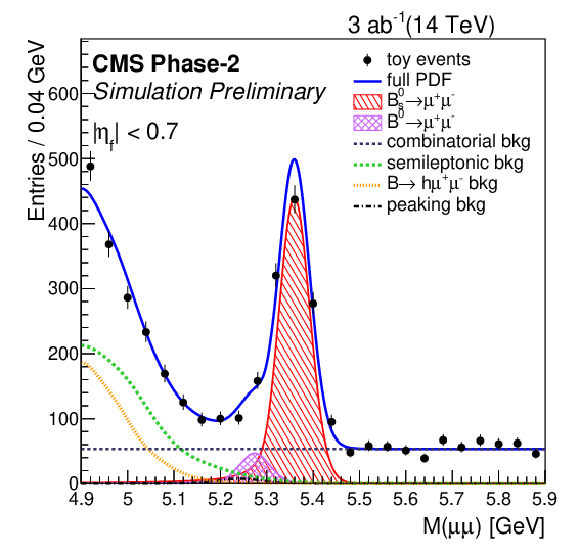

Compact Muon Solenoid
LHC, CERN
| CMS-PAS-FTR-18-013 | ||
| Measurement of rare $\mathrm{B} \to \mu^+\mu^-$ decays with the Phase-2 upgraded CMS detector at the HL-LHC | ||
| CMS Collaboration | ||
| December 2018 | ||
| Abstract: The sensitivity of the upgraded CMS detector for measuring the rare decays $\mathrm{B_{s}}^{0}\to \mu^+ \mu^-$ and $\mathrm{B^0}\to \mu^+ \mu^-$ in the HL-LHC scenario is studied. The upgraded detector, especially with its improved momentum resolution, and the foreseen total integrated luminosity of 3000 fb$^{-1}$ are expected to enable high precision measurements of the branching fractions of $\mathrm{B_{s}}^{0}\to \mu^+ \mu^-$ and the effective lifetime of the $\mathrm{B_{s}}^{0}\to \mu^+ \mu^-$ decay with reduced systematic and statistical uncertainties. At 3000 fb$^{-1}$, it will also be possible to observe the $\mathrm{B^0}\to \mu^+ \mu^-$ decay with more than 5$\sigma$ significance. | ||
| Links: CDS record (PDF) ; inSPIRE record ; CADI line (restricted) ; | ||
| Figures | |

png pdf |
Figure 1:
The left plot shows the ${\mathrm{B_{s}}^{0}}$ and ${\mathrm{B^0}}$ invariant mass distributions in the Run-2 scenario. The right plot shows the ${\mathrm{B_{s}}^{0}}$ and ${\mathrm{B^0}}$ invariant mass distributions for Phase-2. The ${\mathrm{B_{s}}^{0}}$ distribution is normalized to unity and the ${\mathrm{B^0}}$ distribution is normalized according to the SM expectation. |

png pdf |
Figure 1-a:
The plot shows the ${\mathrm{B_{s}}^{0}}$ and ${\mathrm{B^0}}$ invariant mass distributions in the Run-2 scenario. |

png pdf |
Figure 1-b:
The plot shows the ${\mathrm{B_{s}}^{0}}$ and ${\mathrm{B^0}}$ invariant mass distributions for Phase-2. The ${\mathrm{B_{s}}^{0}}$ distribution is normalized to unity and the ${\mathrm{B^0}}$ distribution is normalized according to the SM expectation. |

png pdf |
Figure 2:
(left)Mass distributions for ${\mathrm{B_{s}}^{0}\to {\mu ^+} {\mu ^-}}$ in the Run-2 and Phase-2 scenarios for $|\eta _f| < $ 1.4. A single Gaussian is fit to the core of the mass distribution (see text for details). (right) Mass resolution as a function of $|\eta _f|$. |

png pdf |
Figure 2-a:
Mass distributions for ${\mathrm{B_{s}}^{0}\to {\mu ^+} {\mu ^-}}$ in the Run-2 and Phase-2 scenarios for $|\eta _f| < $ 1.4. A single Gaussian is fit to the core of the mass distribution (see text for details). |

png pdf |
Figure 2-b:
Mass resolution as a function of $|\eta _f|$. |

png pdf |
Figure 3:
Contribution of ${\mathrm{B^0}\to \pi ^- {\mu ^+} \nu}$ background events (with the pion misidentified as a muon) into the signal regions. The ratio of number of ${\mathrm{B^0}\to \pi ^- {\mu ^+} \nu}$ events for Phase-2 to Run-2 is 5/19 in the mass interval 5.2 $ < m < $ 5.3 GeV of the ${\mathrm{B^0}}$ signal region. |

png pdf |
Figure 4:
Normalized isolation variable distributions for the ${\mathrm{B_{s}}^{0}}$ signal for the two pile-up scenarios is shown. The blue distribution represents the case with no pile-up while the red one is for average pile-up of 200 interactions per bunch crossing. In the bottom, the ratio between the PU=0 and the PU=200 distributions is also shown. |

png pdf |
Figure 5:
Invariant mass distributions with the fit projection overlayed, corresponding to an integrated luminosity of 3000 fb$^{-1}$. The left plot shows the central barrel region, $|\eta _{f}| < $ 0.7 and the right plot is for 0.7 $ < |\eta _f| < $ 1.4. |

png pdf |
Figure 5-a:
Invariant mass distribution with the fit projection overlayed, corresponding to an integrated luminosity of 3000 fb$^{-1}$ in the central barrel region, for $|\eta _{f}| < $ 0.7. |

png pdf |
Figure 5-b:
Invariant mass distribution with the fit projection overlayed, corresponding to an integrated luminosity of 3000 fb$^{-1}$ for 0.7 $ < |\eta _f| < $ 1.4. |

png pdf |
Figure 6:
The binned maximum likelihood fit to the background-subtracted decay time distribution for the Phase-2 scenario. The effective lifetime from the fit is 1.61 $\pm $0.05 ps. |
| Tables | |

png pdf |
Table 1:
Input sources of systematic uncertainties and the propagated uncertainties on the ${\mathrm{B} \to \mu ^+\mu ^-} $ branching fractions, $\delta {{\mathcal B}}({\mathrm{B_{s}}^{0}\to {\mu ^+} {\mu ^-}})$ and $\delta {{\mathcal B}}({\mathrm{B^0} \to {\mu ^+} {\mu ^-}})$. |

png pdf |
Table 2:
Mass resolutions for ${\mathrm{B_{s}}^{0}\to {\mu ^+} {\mu ^-}}$ and ${\mathrm{B^0} \to {\mu ^+} {\mu ^-}}$, obtained from Gaussian fits to the core of the respective mass distributions (see text for details). The last column shows the ratio between the Run-2 and Phase-2 resolutions. |

png pdf |
Table 3:
Estimated analysis sensitivity for different integrated luminosities. Columns in the table, from left to right: the total integrated luminosity, the median expected number of reconstructed $ {\mathrm{B_{s}}^{0}} $ and $ {\mathrm{B^0}} $ mesons, the total uncertainties on the ${\mathrm{B_{s}}^{0}\to {\mu ^+} {\mu ^-}}$ and ${\mathrm{B^0} \to {\mu ^+} {\mu ^-}}$ branching fractions, the range of the significance of $ {\mathrm{B^0}} $ observation (the range indicates the $ \pm $1$ \sigma $ of the distribution of significance) and the statistical uncertainty on the ${\mathrm{B_{s}}^{0}\to {\mu ^+} {\mu ^-}}$ effective lifetime. |
| Summary |
| The inner tracker of the Phase-2 detector provides an order of 40-50% improvement on the mass resolutions over the Run-2 case that will allow precise measurements of the $\mathrm{B_{s}}^{0}\to \mu^+ \mu^-$ and $\mathrm{B^0}\to \mu^+ \mu^-$ rare decays. The semileptonic background contribution into the signal regions will be reduced substantially and the improved separation of the $\mathrm{B_{s}}^{0}$ and $\mathrm{B^0}$ yields will lower the signal cross feed contamination, which is crucial for the $\mathrm{B^0}$ observation. With an integrated luminosity of 3000 fb$^{-1}$, CMS will have the capability to measure the $\mathrm{B_{s}}^{0}\to \mu^+ \mu^-$ effective lifetime with an error of about 0.05 ps and to observe the $\mathrm{B^0}\to \mu^+ \mu^-$ decay with more than 5 standard deviation significance. |
| References | ||||
| 1 | A. Ali | Flavour Changing Neutral Current Processes in B Decays | in Proceedings of the Fourth KEK Topical Confernce on Flavor Physics Nuclear Physics B | hep-ph/9702312 |
| 2 | C. Bobeth et al. | $ B_{s,d} \to l^+ l^- $ in the Standard Model with Reduced Theoretical Uncertainty | PRL 112 (2014) 101801 | 1311.0903 |
| 3 | M. Beneke, C. Bobeth, and R. Szafron | Enhanced electromagnetic correction to the rare $ B $-meson decay $ B_{s,d} \to \mu^+ \mu^- $ | PRL 120 (2018), no. 1, 011801 | 1708.09152 |
| 4 | A. J. Buras and J. Girrbach | BSM models facing the recent LHCb data: A First look | Acta Phys.Polon. B43 (2012) 1427 | 1204.5064 |
| 5 | A. J. Buras, R. Fleischer, and J. Girrbach | Probing New Physics with the $ B_{s}\to \mu^+ \mu- $ Time-Dependent Rate | JHEP 1307 (2013) 77 | 1303.3820 |
| 6 | Y. Amhis, S. Banerjee, E. Ben-Haim et al. | Averages of b-hadron, c-hadron, and $ \tau $-lepton properties as of summer 2016 | EPJC77 (2017) 895 | 1612.07233 |
| 7 | CMS Collaboration | Measurement of the $ B_{s}^{0}\to \mu^+\mu^- $ Branching Fraction and Search for $ B^0\to \mu^+\mu^- $ with the CMS Experiment | Phys.Rev.Lett. 111 (2013) 101804 | CMS-BPH-13-004 1307.5025 |
| 8 | ATLAS Collaboration | Study of the rare decays of $ B_{s}^{0} $ and $ B^{0} $ into muon pairs from data collected during the LHC Run 1 with the ATLAS detector | EPJC76 (2016) 513 | 1604.04263 |
| 9 | LHCb Collaboration | Measurement of the $ B_{s}^{0} \to \mu^+ \mu^- $ branching fraction and search for $ B_{0} \to \mu^+ \mu^- $ at the LHCb experiment | PRL 111 (2013) 101805 | 1307.5024 |
| 10 | CMS and LHCb Collaboration | Observation of the rare $ B_{s}^{0} \to \mu^+ \mu^- $ decay from the combined analysis of CMS and LHCb data | Nature 522 (2015) 68--72 | 1411.4413 |
| 11 | ATLAS Collaboration | Study of the rare decays of $ B_{s}^{0} $ and $ B^{0} $ into muon pairs from data collected during 2015 and 2016 with the ATLAS detector | ATLAS CONF Note 2018-046 | |
| 12 | LHCb Collaboration | Measurement of the $ B_{s}^{0} \to \mu^+ \mu^- $ branching fraction and effective lifetime and search for $ B_{0} \to \mu^+ \mu^- $ decays | PRL 118 (2017) 191801 | 1703.05747 |
| 13 | CMS Collaboration | The Phase-2 Upgrade of the CMS Tracker | CDS | |
| 14 | GEANT4 Collaboration | GEANT4: A Simulation toolkit | NIMA506 (2003) 250--303 | |
| 15 | CMS Collaboration | Performance of CMS muon reconstruction in $ pp $ collision events at $ \sqrt{s}= $ 7 TeV | JINST 7 (2012) P10002 | CMS-MUO-10-004 1206.4071 |
| 16 | PDG Collaboration | The Review of Particle Physics | PRD 98 (2018)030001 | |
| 17 | M. Pivk and F. R. Le Diberder | SPlot: A Statistical tool to unfold data distributions | NIMA555 (2005) 356--369 | physics/0402083 |
| 18 | LHCb Collaboration | Measurement of the fragmentation fraction ratio $ f_{s}/f_{d} $ and its dependence on B meson kinematics | JHEP 04 (2013) 001 | 1301.5286 |
| 19 | T. Sjostand and et al. | An introduction to PYTHIA8.2 | Comput.Phys.Commun. 191 (2015) 159--177 | 1410.3012 |
| 20 | D. J. Lange | The EvtGen particle decay simulation package | NIMA462 (2001) 152--155 | |
| 21 | P. Golonka and Z. Was | PHOTOS Monte Carlo: A Precision tool for QED corrections in Z and W decays | EPJC45 (2006) 97--107 | hep-ph/0506026 |
| 22 | A. Khodjamirian, C. Klein, T. Mannel, and Y. M. Wang | Form Factors and Strong Couplings of Heavy Baryons from QCD Light-Cone Sum Rules | JHEP 09 (2011) 106 | 1108.2971 |

|
Compact Muon Solenoid LHC, CERN |

|

|

|

|

|

|